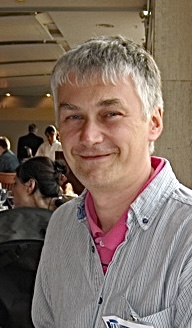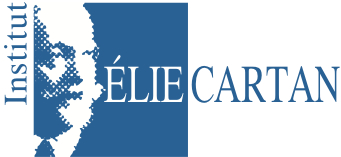 English version
English version
JOURNÉES SL2R
(Strasbourg, Lorraine, Louvain-la-Neuve, Luxembourg, Reims)
THÉORIE DES REPRÉSENTATIONS ET ANALYSE HARMONIQUE
en l'honneur du 60e anniversaire de
Pavle Pandžić
|

|
Organisateurs :
Philippe Bonneau, Salah Mehdi, Angela Pasquale
Programme
Conférenciers :
Alexandre AFGOUSTIDIS (Université de Lorraine)
Léa BITTMANN (Université de Strasbourg)
Hrvoje KRALJEVIĆ (University of Zagreb)
Andrey KRUTOV (Charles University)
Salah MEHDI (Université de Lorraine)
Martin OLBRICH
(Université du Luxembourg)
Ana PRLIĆ
(University of Zagreb)
Haluk
ŞENGÜN
(University of Sheffield)
Rupert YU
(Université de Reims)
Exposés
:
Petit Amphi, Bâtiment UFR-MIM
Pauses café :
Salle des conférences de l'IECL
Programme :
Les journées débuteront le jeudi 9
au début de l'après midi avec un exposé
autour des opéteurs de Dirac à l'attention du « grand public » et plus spécifiquement des doctorant.e.s, futur.e.s doctorant.e.s et les étudiant.e.s de master passionné.e.s par les mathématiques fondamentales.
Jeudi 9 novembre 2023
Vendredi 10 novembre 2023
| 8h45-9h45 |
Rupert YU :
On a combinatorial problem concerning seaweed Lie algebras
|
| 9h45-10h15 |
Pause Café
|
| 10h15-11h15 |
Haluk ŞENGÜN :
Theta correspondence via $C^*$-algebras
|
| 11h15-12h15 |
Martin OLBRICH :
The continuous spectrum of certain compact locally symmetric spaces
|
| 12h20 |
Repas |
| 14h00-15h00 |
Léa BITTMANN :
Skein modules and Double Affine Hecke Algebras
|
| 15h00-16h00 |
Alexandre AFGOUSTIDIS :
Recent developments on supercuspidal representations
|
Titres et
résumés des exposés :
Exposé grand public
Salah MEHDI :
Dirac ou l'incroyable odyssée mathématique d'un électron libre
Entre 1900 et 1915, anni mirabiles, les physiciens allemands Albert Einstein et Max Planck révolutionnent la Physique et renvoient Newton au vestiaire. La théorie des quanta et la théorie de la relativité défient l'intuition et ouvrent les portes d'un vaste monde jusqu'alors invisible, un monde peuplé d'atomes autour desquels gravitent, à des vitesses folles, des nuées de particules. Dans ces ruches atomiques, tous les regards se portent sur la reine, légère (environ $9\times 10^{-31}$ kilogrammes) et tournoyante (avec spin $\frac{1}{2}$), nommée électron. Mais la reine attise les convoitises. En 1925, les paparazzi de l'atome tiennent un scoop : le physicien autrichien Erwin Schrödinger modèlise les allers et venues quantiques mais non-relativistes de l'électron. L'année suivante le suédois Oskar Klein et l'allemand Walter Gordon parviennent à relativiser le modèle sans toutefois inclure le spin. Ainsi, en dépit de son agilité et de sa double-vie, le chat de Schrödinger ne parvient pas à espionner la reine qui continue de faire tourner les têtes. Pour la énième fois, les physiciens théoriciens ont le spleen et se retrouvent dans une impasse : comment d'écrire à l'aide de fonctions d'ondes scalaires la dynamique quantique relativiste d'une particule possédant un spin non-nul ? Il faudra toute l'audace et le génie du jeune physicien britannique Paul Dirac pour lever le voile sur la reine. En 1928, à l'âge de $25$ ans, Dirac mène la danse et fait un bond en avant pour sortir des sentiers battus : il propose une équation à solutions vectorielles qui capture les aspects quantique, relativiste et spinoriel de l'électron libre. Echec et Math, la reine des particules abdique après plus de $13$ milliards d'années passées sur le trône subatomique. La formule magique du jeune révolutionnaire repose pourtant sur un simple opérateur différentiel de degré $1$ à coefficients constants matriciels. L'opérateur de Dirac est né, son immense royaume va s'étendre jusqu'aux confluents des mathématiques : algèbre, analyse et géométrie. Dans cet exposé, nous évoquerons quelques épisodes de l'incroyable odyssée de l'opérateur de Dirac, notamment ses contributions à la théorie des groupes, à la topologie et à l'analyse sur les variétés. En particulier, nous expliquerons en quoi la notion d'invariance est le fil d'Ariane de la plupart des théories physiques et mathématiques. Mais disons-le d'emblée : tout comme l'électron jadis, l'opérateur de Dirac intrigue et fascine. Il n'a pas encore livré tous ses secrets, l'aventure continue ...
Hrvoje KRALJEVIĆ:
A glimpse into the work of Pavle Pandzic
On the occasion of the 60th birthday of Pavle Pandzic I will give short overview of his career. Furthermore, I will try to present his achievements in representation theory, especially by using Dirac operators.
Ana PRLIĆ :
Alternative proof of the classification of unitary highest weight modules
In this talk, we give an alternative proof of the classification of unitary highest weight modules given by Enright, Howe and Wallach
(and independently by Jakobsen). This is joint work with Pavle Pandžić, Vladimir Souček and Vit Tuček.
Andrey KRUTOV:
Cubic Dirac operator for $U_q(\mathfrak{sl}_2)$
Alekseev and Meinrenken developed a noncommutative equivariant de Rham theory for homogeneous manifolds equipped with a transitive action of a Lie group $G.$ This led to the definition of a noncommutative Weil algebra related to the algebra $\mathfrak{g}$ of $G$. If the Lie algebra $\mathfrak{g}$ admits a nondegenerate invariant bilinear form, then the noncommutative Weil algebra comes equipped with a cubic Dirac element. Since this Dirac element squares to a scalar, it can be seen as an algebraic Dirac operator. Such Dirac operators have numerous applications in geometry and representation theory. In particular, they were used to give a new proof of the celebrated Duflo theorem.
We define the $q$-deformed noncommutative Weil algebra for the quantum group $U_q(\mathfrak{sl}_2)$ and the corresponding cubic Dirac element. We calculate the spectrum of the Dirac operator and the corresponding Dirac cohomologies for finite-dimensional and Verma modules over $U_q(\mathfrak{sl}_2)$.
This is joint work with Pavle Pandžić (Zagreb).
Rupert YU : On a combinatorial problem concerning seaweed Lie algebras
Seaweed Lie algebras were introduced
by Dergachev and Kirillov in 2000 and provided
many new examples of complex Frobenius Lie
algebras, that is, a Lie algebra whose coadjoint
action has an open orbit. The original definition
is only for gl(n), and the notion was generalized
by Panyushev to any reductive Lie algebras. As in
the case of parabolic subalgebras in a reductive
Lie algebra, any seaweed Lie algebra is conjugate
to some standard one. Duflo et Elashvili observed
independently some behaviour on the growth of the
number of standard Frobenius seaweed Lie algebras
in gl(n) with respect to n. In this talk, we shall
present some results concerning the validity of
these observations.
This is based on joint works with Michel Duflo.
Haluk ŞENGÜN : Theta correspondence via $C^*$-algebras
The local theta correpsondence sets up a bijection between
certain subsets of admissible duals of suitable pairs of reductive
groups. There are two special cases in which the correspondence is known
to enjoy extra features, the ‘equal rank’ case where temperedness is
preserved and the ‘stable range’ case where unitarity is preserved.
In joint work with Bram Mesland (Leiden), we show that in these special
cases, the local theta correspondence is actually given by a Morita
equivalence of suitable $C^*$-algebras. I will try to expose this result
and, time permitting, some applications.
Martin OLBRICH : The continuous spectrum of certain compact locally symmetric spaces
Let $X=G/H$ be a semi-simple non-Riemannian symmetric space. We consider compact `standard quotions' $Y$ of $X$: There exists a reductive connected subgroup $L\subset G$
acting transitively on $X$ with compact stabilizers and a cocompact discrete subgroup $\Gamma\subset L$ such that $Y=\Gamma\backslash X$. We are interested in the joint spectral
decomposition of $L^2(Y)$ with respect to the action of the algebra $D(G/H)$ of $G$-invariant differential operators on $X$. There is a sufficient criterion in terms
of the triple $(G,H,L)$, which ensures that the spectral decomposition is purely discrete. We conjecture that this criterion is also necessary. In particular, many compact standard quotients
should have continuous spectrum. We give reasons to believe in this conjecture and verify it in the simplest cases (which are connected with $SL(2,\mathbb{R}$).
This is joint work with Salah Mehdi.
Léa BITTMANN : Skein modules and Double Affine Hecke Algebras
The type A Hecke algebra of rank n is a deformation of the group algebra of the braid group on n strands $\mathcal{B}_n$. This is true in more generality, in particular, the affine Hecke algebra is a deformation of the group algebra of the affine braid group, which can be defined as braids in a (thickened) annulus. As such, the affine Hecke algebra is the braid skein algebra of the annulus. Morton and Samuelson have proved that the Double Affine Hecke Algebra (DAHA) is isomorphic to the braid skein algebra of the punctured torus. They also conjectured that these were isomorphic to the corresponding tangle skein algebra, where braids are replaced by tangles (or ribbons). In this talk, I will present a proof of the Morton-Samuelson conjecture, and a classification of a class of representation of the DAHA using doubly periodic tableaux. This is based on joint work with A. Chandler, A. Mellit and C. Novarini.
Alexandre AFGOUSTIDIS :
Recent developments on supercuspidal representations
[This will be a ''dress rehearsal'' for my talk at the Bourbaki seminar on November 18]
Let $G$ be a reductive group over a nonarchimedean local field $F$. In the quest for a classification of irreducible smooth representations of $G$, it is critical to understand the case of supercuspidal representations---those with compact-mod-center matrix coefficients. Progress in understanding these representations has been continuous over the past fifty years. In ``tame'’ cases where the residual characteristic of $F$ is big enough for $G$, a fairly general construction was described by J-K. Yu in 2001, building on a large body of work. But recent developments have made the general picture much more complete and much clearer. For instance, the work of J. Fintzen, T. Kaletha and L. Spice includes (in the tame case) a classification of supercuspidal representations, an explicit formula for ``almost all'' their characters, and an explicit construction of a local Langlands correspondence for supercuspidal L-packets. While the basic constructions crucially involve Bruhat--Tits buildings and representations of finite groups, the resulting character formulas and the description of $L$-packets have striking parallels with the case of real groups.
Participants
(liste mise à jour le 12/10/2023)
- Spyridon AFENTOULIDIS-ALMPANIS (Bar-Ilan University)
- Alexandre AFGOUSTIDIS (CNRS & Université de Lorraine)
- Wolfgang BERTRAM (Université de Lorraine)
- Léa BITTMANN (Université de Strasbourg)
- Philippe BONNEAU (Université de Lorraine)
- Jean-Louis CLERC (Université de Lorraine)
- David DECLERCQ-LUCET (Université de Reims)
- Karmen GRIZELJ (University of Zagreb)
- Auguste HÉBERT (Université de Lorraine)
- Perrine JOUTER (Université de Reims)
- Hrvoje KRALJEVIĆ (University of Zagreb)
- Andrey KRUTOV (Charles University)
- Gang LIU (Université de Lorraine)
- Valentin MARIE (Université de Reims)
- Hugo MATHEVET (Université de Reims)
- Salah MEHDI (Université de Lorraine)
- Victor NISTOR (Université de Lorraine)
- Martin OLBRICH (University of Luxembourg)
- Valentin OVSIENKO (Université de Reims)
- Guenda PALMIROTTA (Université du Luxembourg)
- Pavle PANDZIC (University of Zagreb)
- Angela PASQUALE (Université de Lorraine)
- Aurélie PAULL (Université de Lorraine)
- Emmanuel PEDON (Université de Reims)
- Ana PRLIĆ (University of Zagreb)
- Nicolas PRUDHON (Université de Lorraine)
- Haluk ŞENGÜN (University of Sheffield)
- Rafailia TSIAVOU (Aristotle University of Thessaloniki)
- Rupert YU (Université de Reims)
- Bob YUNCKEN (Université de Lorraine)
Inscription
Les personnes souhaitant participer à ces journées et/ou à l'exposé « grand public » sont invitées à remplir le formulaire d'inscription ci-dessous
et de l'envoyer
à Angela Pasquale (angela.pasquale_at_univ-lorraine.fr ) au plus tard le 13 octobre 2023. L’inscription est gratuite mais obligatoire, pour mieux anticiper l’organisation du colloque
(exposés, repas, ...).
Formulaire
d'inscription
Hôtels
La liste des hôtels messins du site de l'office de tourisme de Metz
est ici.
Contacts
Secrétariat :
IECL, Université de Lorraine, UFR-MIM, 3 rue Augustin Fresnel,
57070 Metz
Email : iecl-math-saf_at_univ-lorraine.fr
Renseignements :
Pour tout renseignement, vous pouvez contacter l'un des organisateurs :
Philippe Bonneau,
Salah Mehdi, ou
Angela Pasquale





